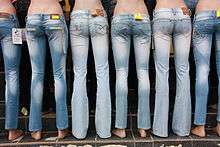Low-rise pants
Low-rise pants, also known as "low-cut jeans", "lowriders" or "rap pants", are a type of pants that sit low on, or below, the hips, usually at least 8 centimetres (3 inches) lower than the navel. Low-rise pants have been available since the 1900s, in styles for both men and women, with popularity increasing in the 2000s.

Terminology
The "rise" of any bottom apparel is determined by the distance between the crotch and the waist and is usually around 30 cm (12 inches) on regular pants. In comparison, the average measurement of low-rise trousers is roughly 20 cm (8 inches), with some as little as 7–10 cm (3-4 inches). Several jeans brands also reflect the rise on the zipper, by creating pants with zippers far shorter than regular pants, usually between 5 and 7 cm (2-3 inches), and some manufacturers, such as Dorinha Jeans Wear, even provide 2.5 cm (1 inch) zippers. The latter can also be classified as "ultra low-rise jeans", and the small zipper no longer has its traditional function, but is rather a display of fashion.[1]
History
Hip-huggers, the precursor to low-rise pants, rose to popularity during the mid 1960s due to the mod subculture, and eventually by the hippies in the late 1960s. Often worn with light-cotton, paisley-printed tops or nehru-collared jackets, bell-bottomed hip-huggers were popularized by rock icons such as Jimi Hendrix, Janis Joplin, Jim Morrison, and Robert Plant. Later, hip-huggers became a staple of popular culture and were incorporated into the disco scene of the 1970s.[2]
During the late 1970s and early 1980s, however, waistlines moved higher as wide, flared, bell-bottoms gradually gave way to designer straight-legged jeans. Throughout the 1980s and into the 1990s, as more women entered the corporate workforce, the high waist design remained predominant, with commercial designers such as Gloria Vanderbilt and Calvin Klein at the forefront.
The 1990s revival of low-rise jeans can be credited to British fashion designer Alexander McQueen, who first showed his famous low-rise "bumster" trousers in his 1996 "Taxi Driver" collection show. One commentator observed: "The bumster for me is what defined McQueen. For me it was the look that put him on the map because it was controversial. Those little bumsters were in his first shows. It was like 20 people in England were wearing them back then."[3][4] Following McQueen's lead, the fashion of low-rise pants gradually spread. The iconic low-rise fashion emerged in 2000, particularly among youth; Britney Spears is most credited with popularizing the fashion in the US after she started wearing them that same year.[5][6] Although its popularity also increased among women and men of other ages, the major focus of advertising is still directed at teenage girls and boys, with typical teen stores selling low-rise jeans in different styles and colors. Most American teenage and twenty-something-oriented retail stores that carry jeans (e.g., Guess, American Eagle, Abercrombie & Fitch, Stitches) only or mostly carry low-rise jeans.
Styles

Low-rise jeans are manufactured in many styles, including boot-cut, flared, loose, straight, baggy, skinny, boyfriend, and slim. Due to the popularity of low-rise jeans, manufacturers have also begun making low-rise styles of other kinds of pants, such as cargo pants and dress pants.
Low-rise jeans may be worn to display more skin at the waist, torso, and hips. Accordingly, they are sometimes worn in combination with crop tops, giving a glimpse of skin between the jeans and the top, or (more commonly in the summer or in warmer countries) showing their entire midriff including the navel. From 2001 to 2007, the low rise style frequently revealed the thong or G-string underneath, but after 2007 this fell out of favor and thongs began their decline. When the wearer sits down or bends forward, sometimes cleavage is visible. When a thong is exposed above a pair of low-rise jeans on the back, it is commonly referred to as a whale tail, due to its somewhat similar shape. When boxer shorts become visible this is known as "sagging". Because underwear was no longer always hidden, more men and women choose their underwear to function with their low-rise jeans.[7][8]
Medical concerns
In the Canadian Medical Association Journal 2003, Dr. Malvinder S. Parmar pointed out that wearing tight low-rise jeans may put pressure on a sensory nerve, the lateral cutaneous nerve of the thigh, which can cause pain and paresthesia in the nerve's area of distribution. This is known as meralgia paresthetica and is associated with a tingling or a burning sensation on the lateral aspect of the thigh. The condition was diagnosed in three obese women who had worn low-rise jeans for 6–8 months. The condition resolved itself after they avoided wearing low-rise jeans for 4–6 weeks.
 Diagram of segmental distribution of the lateral cutaneous nerve (shaded) and other nerves of the right lower extremity. Front view.
Diagram of segmental distribution of the lateral cutaneous nerve (shaded) and other nerves of the right lower extremity. Front view.- Cutaneous nerves of the right lower extremity. Front and posterior views.
See also
- Navel in popular culture
- Hip-huggers
- Jean skirt
- Crop top
- Buttock cleavage
- Halterneck
- Muffin top
- Sagging (fashion)
References
- Good Girls Don't Have to Dress Bad: A Style Guide for Every Woman - Shari Braendel.
- "Hip Huggers". Retrieved 2 July 2014.
- Rajini Vaidyanathan (12 February 2010). "Six ways Alexander McQueen changed fashion". BBC News Magazine. BBC. Retrieved 27 May 2012.
- "Alexander McQueen Fashion Designer (1969 - 2010)". Design Museum: London. British Council. Archived from the original on 23 November 2010. Retrieved 27 May 2012.
- "Jeans Rising". The Daily Beast. Newsweek Magazine. 26 March 2006. Retrieved 27 May 2012.
- "Archived copy". Archived from the original on 2011-07-11. Retrieved 2008-10-25.CS1 maint: archived copy as title (link)The Gilroy Dispatch - Low-rise Jeans Unflattering to Moms - Thanks a Lot, Britney Spears
- Janelle Brown, "Here come the buns", Salon.com, May 28, 2002.
- Jennifer D'Angelo, "Cleavage Fashion Flips Upside Down", FOXNews.com, December 5, 2001.